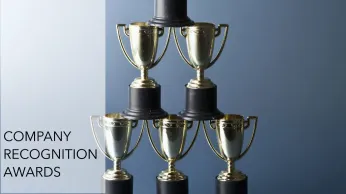¿Quién defenderá el descanso y la recuperación de los empleados en el lugar de trabajo digital?
En el lugar de trabajo 4.0, un programa digital de R&R ayuda a atraer y retener a los mejores talentos. Este programa debe ser impulsado por un Comité de R&R dedicado, en colaboración con directivos y empleados, mientras que RRHH asume el papel de facilitador. Más información en el blog.
En esta página
"Para ganar en el mercado primero hay que ganar en el lugar de trabajo".
-Doug Conant, líder empresarial estadounidense (ex Consejero Delegado de Campbell Soup Company y Presidente de Nabisco Foods).
↣ El compromiso, la productividad y el rendimiento de los empleados son un 14% mayores que en las organizaciones sin reconocimiento.
↣ Una mejora del 15% en el compromiso puede traducirse en un aumento del 2% en los márgenes.
Pero, ¿quién impulsará las iniciativas de R&R de los empleados de la forma "correcta"? ¿Debe ser RRHH o debe ser un esfuerzo de toda la organización?
No se puede negar que RR.HH. supervisa la administración y aplicación de su programa de recompensa y reconocimiento.

Como se desprende de esta tabla, RR.HH. tiene una mayor visibilidad sobre el rendimiento de la organización en las PYMES y las nuevas empresas, pero en las grandes empresas, se convierte en un reto debido a la escala. Sin embargo, en todos estos casos, RR.HH. puede seguir cumpliendo su función tradicional de impulsar los programas de R&R de forma significativa.
En el lugar de trabajo 4.0, sin embargo, RR.HH. es clave para el éxito de la organización. A medida que RRHH pasa a desempeñar un papel estratégico, debe identificar quién puede asumir la responsabilidad de impulsar las iniciativas de R&R en el día a día.
Un programa moderno de R&R debe ser un esfuerzo de colaboración entre RRHH, directores funcionales, jefes de equipo y empleados.
¿Cuál es el papel de RRHH en los programas de recompensa y reconocimiento?

El primer paso estratégico de RRHH sería definir el marco de R&R. He aquí algunas preguntas cruciales que hay que plantearse:
- ¿Qué comportamientos de los empleados quiere fomentar la organización a través del R&R?
- ¿Cuáles son los criterios de admisibilidad?
- ¿Cómo deben determinarse los ganadores?
- ¿Cuáles deberían ser las categorías?
- ¿Cuáles deberían ser las recompensas reales?
- ¿Los programas de R&R deben ser totalmente online o una mezcla de iniciativas online y offline?
- ¿Deben los RRHH depender de la tecnología heredada o aprovechar los modelos SaaS?
- ¿Cuál debe ser la frecuencia del programa?
- ¿Quién puede participar en la entrega y recepción de reconocimientos?
Si pensaba que RRHH define este marco de forma aislada, DETÉNGASE.
Supongamos que la idea es promover la democracia en el lugar de trabajo: RR.HH. puede considerar la posibilidad de incluir a directivos, jefes de equipo y empleados "influyentes". (¿Recuerdas esa voz solitaria que grita "¡Whoopee!" en los ayuntamientos de los empleados mientras todos los demás empiezan a vitorear).
Ya tiene su comité, sus paladines para impulsar las iniciativas de R&R desde la vanguardia.
Entre en el comité de recompensas y reconocimiento.
¿Qué hace un comité de recompensa y reconocimiento?
Esta alegre banda que se ha reunido ahora es el típico comité de R&R; colaboradores que entienden lo que hace que su organización funcione, pueden identificar lo que hace que la cultura de su empresa sea única y destacar aquellos comportamientos "críticos" que impulsan a esta unidad cohesionada hacia el éxito.
Contar con este comité de R&R bien elegido envía un mensaje claro: "Nos tomamos en serio el reconocimiento de nuestros empleados porque realmente valoramos sus contribuciones".
Una vez definido el marco de recompensas y reconocimiento, es hora de que el comité tome las riendas:
1. Popularizar las iniciativas de R&R
Las conversaciones en la fuente de agua (ahora que algunas empresas están dando la bienvenida a los empleados de vuelta a espacios de oficina "seguros") y los chats de Slack/MS Teams (para los que trabajan a distancia) son lugares estupendos para entablar conversaciones en torno al descanso y la relajación.
2. Utilizar una comunicación clara y coherente
El éxito de cualquier programa de R&R depende de cómo lo perciban los trabajadores.
"Lacomunicación eficaz es un 20% lo que sabes y un 80% lo que sientes sobre lo que sabes". -Jim Rohn, empresario y orador motivacional estadounidense.
3. Promover los cambios culturales necesarios
Cada vez que el Comité note desinterés y muecas cuando se habla de los R&R, o las nominaciones no lleguen a tiempo, o los gerentes y jefes no los promuevan, "Es hora de dar un paso al frente". Aborde las denuncias de favoritismo o cualquier prejuicio oculto. Reúne a tus tropas.
4. Aumentar la adopción combinando herramientas tecnológicas y comprensión humana
Las herramientas de análisis de datos proporcionan información sobre los niveles de participación en los distintos equipos y zonas geográficas. Un comité bien interconectado puede obtener información interesante, como la relación directa entre el reconocimiento, el rendimiento de los empleados y los índices de aprobación de los directivos.
5. Recoger información para mejorar los programas de i+r
Dados los modelos de trabajo híbridos que prevalecen en la actualidad, el uso de herramientas automatizadas que realicen encuestas en línea periódicamente ayudará a crear un proceso continuo de medición y mejora de las iniciativas de R&R mediante encuestas de opinión a los empleados.
¿Harán los Swedish House Mafia que el papel de los managers sea redundante?
Los directivos siguen siendo los más indicados para identificar en sus equipos a los trabajadores más productivos y a los "héroes anónimos". Sin embargo, los propios directivos deben recibir formación sobre el mérito de la meritocracia.
La formación podría incluir la comprensión de los KPI rutinarios, la identificación de cambios de comportamiento y la aplicación de medidas tácticas en beneficio de la organización.
Los directivos pueden ser los campeones del programa R&R y utilizarlo eficazmente para aumentar la satisfacción y la productividad de los empleados. He aquí cómo:
1. Identificar el "buen comportamiento" que construye la cultura
¿Es la pasión, la innovación o el rendimiento constante? ¿Es la participación o ser un jugador de equipo lo que tiene un valor incalculable? ¿Se trata de mostrar los valores de la organización?
2. Inculcar disciplina y método
Garantizar que los jefes de equipo envíen las nominaciones a tiempo, siempre; orientar y asesorar a los TL para que sigan procesos específicos, etc., puede ayudar a crear un enfoque disciplinado.
3. Animar a los TL y a las cohortes a adoptar la tecnología
En industrias tradicionales como la manufacturera, hay reticencia a adoptar incluso las tecnologías más sencillas, incluidas las encuestas en línea, y aquí es donde el directivo toma las riendas.
4. Sensibilización sobre los criterios de admisibilidad
" No he hecho lo suficiente. Sólo ha sido un artículo publicado en una revista", o "Yo sólo he aportado una idea pero otro la ha construido", son dudas reales que tienen los empleados. Como directivo, puedes mostrar cómo las acciones o iniciativas de los empleados contribuyen al crecimiento general de la empresa y cómo esas iniciativas pueden dar lugar a nominaciones de R&R.
Y por último, el empleado. Esta cita lo resume todo.
"Ninguna empresa, pequeña o grande, puede ganar a largo plazo sin empleados llenos de energía que crean en la misión y entiendan cómo lograrla". -Jack Welch, ex Consejero Delegado de General Electric
Cuando los empleados entienden cómo les benefician los programas de R&R, les ayudan a mejorar la productividad en el lugar de trabajo y a aumentar su eficiencia, se convertirán en los defensores de las iniciativas de R&R y de todo lo que una organización se esfuerza por conseguir.
Reconocer a los compañeros de equipo puede ser el primer paso para generar confianza entre iguales. Ésta es la base de los equipos de alto rendimiento. A medida que los compañeros trabajan juntos, pueden compartir un relato de primera mano sobre los comportamientos ejemplares y el rendimiento ofrecido en el trabajo.
Si anima a todos los empleados a apreciar a sus compañeros, puede crear una cultura de reconocimiento y gratitud en su organización.













